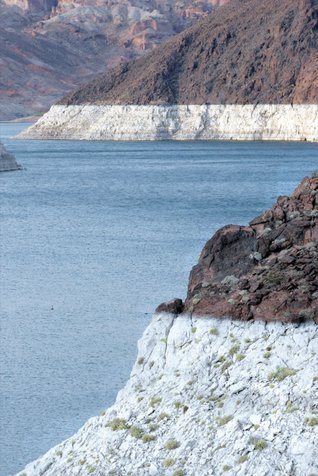
Near the Hoover Dam, the difference in the color of the rocks shows how high the water level in Lake Mead has been. Drought on the Colorado River has reduced the region’s water reserves.
Thursday, Jan. 3, 2013 | 2:02 a.m.
View more of the Sun's opinion section
Another view?
View more of the Las Vegas Sun's opinion section:
• Editorials - the Sun's viewpoint.
• Columnists - local and syndicated writers.
• Letters to the editor - readers' views.
Have your own opinion? Write a letter to the editor.
A study released last week by the Bureau of Reclamation confirms what everyone already knows: We are sucking more water out of the Colorado River Basin than nature is putting in.
Like draining a savings account, water users in the seven basin states (Wyoming, Colorado, Utah, New Mexico, Arizona, Nevada and California) and Mexico have been drawing down Lake Powell and Lake Mead by about a million more acre-feet of water than rain and snowmelt provide each year.
According to the bureau, users’ plans for yet more pipelines combined with the effects of global warming will push the annual deficit as high as 8 million acre-feet by 2060, a cataclysmic shortfall.
What’s the bureau’s answer? It includes some laudable conservation measures in cities and on farms, but also a number of schemes to “augment” the water supply; notably, a multibillion-dollar plan to pump water from the Missouri River 670 miles and a mile uphill from Kansas to Denver, and another plan to tow Arctic icebergs down the Pacific Coast.
Peddling such boondoggles has a long history. In decades past, the bureau and other agencies have proposed tunneling through multiple mountain ranges to divert the Klamath and Columbia rivers southward. In the 1960s, a federal plan, Operation Ploughshare, considered using nuclear bombs to clear the way to divert the Yukon River to Los Angeles.
Fortunately, none of these schemes got off the drawing board, and the new crop shouldn’t either. Instead, we in the Colorado River basin need to make do with the water we have. We can do it, now and well into the future, if we are willing to look beyond the traditional approach to managing the river.
First, cities can keep getting more efficient. Las Vegas has cut its per-capita water use from 348 gallons per day to 240 in 20 years; Tucson residents use just 100 gallons per day. Farmers can, too. Agriculture uses 85 to 90 percent of Colorado River water, water so heavily subsidized that most goes to grow thirsty, low-value cattle feed, including 50 billion gallons a year for alfalfa that is shipped to China.
What is lacking in the study’s options is the easiest and cheapest way to save water: cutting waste in the system itself. Lake Mead and Lake Powell lose huge volumes of water to evaporation in the desert sun and to seepage into the dry ground. By consolidating the water in Lake Mead, the bureau could save as much as 300,000 acre-feet a year — equal to Nevada’s entire entitlement.
The bureau has failed to consider this approach in part because it has collected data only on evaporation rates and concluded the savings don’t justify consolidation. But new studies show higher evaporation rates and that the cracked sandstone underlying Lake Powell has sucked up 18 million acre-feet of water since the dam was built.
Maximizing storage in Lake Mead — and keeping Lake Powell for use only during rare wet years — faces a political battle because Powell is seen as holding upper-basin water and Mead as lower-basin water. In fact, the legal allocations among the two sets of users can be met and maintained without the need for both reservoirs.
Moreover, making the shift could be done at virtually no cost and with no need to change the laws that govern water in the basin. Indeed, the bureau is already prioritizing storage in Mead. With an equalization policy adopted in the past two years, extra water has been released from Powell to Mead to keep the latter from dropping low enough to trigger politically disastrous shortages among some lower-basin users. In November, an agreement was signed with Mexico allowing it to store some of its water in Mead, as well.
Moving more water to Lake Mead would not only protect the water supply; it would also begin to heal the ecological damage that Lake Powell has wreaked on Glen Canyon and the Grand Canyon.
Most of Glen Canyon’s 3,000 miles of side canyons would be uncovered, and diverting water from Powell would send downstream the warmer water and higher flood flows that the Grand Canyon’s ecosystem requires. (A way to move some of the sediment blocked by Glen Canyon Dam into the Grand Canyon would probably also be required to fully reverse the canyon’s precipitous ecological decline.)
The long-term problems of the Colorado River basin are enormous, complex and politically fraught. But in the short and medium terms, the Bureau of Reclamation ought to take the immediate, reasonable, doable steps that would save water and begin the restoration of Glen Canyon and the Grand Canyon, nearly 400 miles of irreplaceable landscape at the heart of the Colorado Plateau.
Wade Graham is an adjunct professor of public policy at Pepperdine University, a trustee of the Glen Canyon Institute and the author of “American Eden.” He wrote this for the Los Angeles Times.

Join the Discussion:
Check this out for a full explanation of our conversion to the LiveFyre commenting system and instructions on how to sign up for an account.
Full comments policy